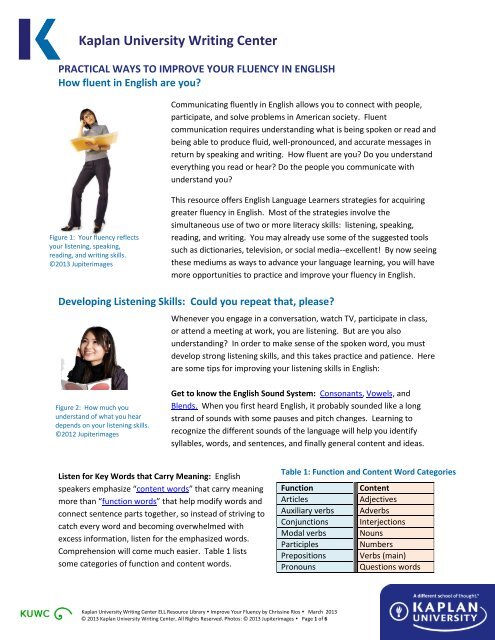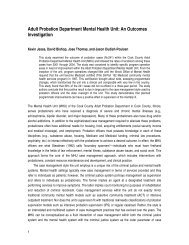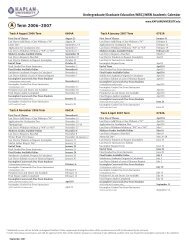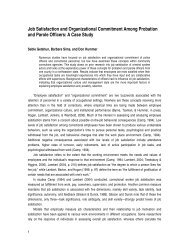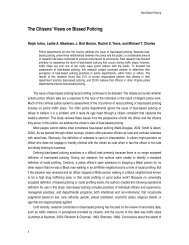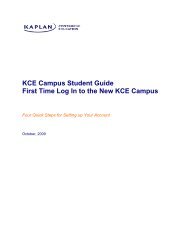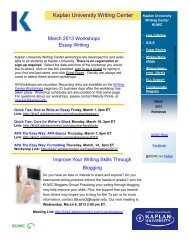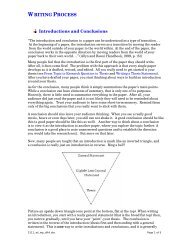Practical Ways to Improve Your Fluency in English - Kaplan ...
Practical Ways to Improve Your Fluency in English - Kaplan ...
Practical Ways to Improve Your Fluency in English - Kaplan ...
Create successful ePaper yourself
Turn your PDF publications into a flip-book with our unique Google optimized e-Paper software.
<strong>Kaplan</strong> University Writ<strong>in</strong>g CenterPRACTICAL WAYS TO IMPROVE YOUR FLUENCY IN ENGLISHHow fluent <strong>in</strong> <strong>English</strong> are you?Communicat<strong>in</strong>g fluently <strong>in</strong> <strong>English</strong> allows you <strong>to</strong> connect with people,participate, and solve problems <strong>in</strong> American society. Fluentcommunication requires understand<strong>in</strong>g what is be<strong>in</strong>g spoken or read andbe<strong>in</strong>g able <strong>to</strong> produce fluid, well-pronounced, and accurate messages <strong>in</strong>return by speak<strong>in</strong>g and writ<strong>in</strong>g. How fluent are you? Do you understandeveryth<strong>in</strong>g you read or hear? Do the people you communicate withunderstand you?Figure 1: <strong>Your</strong> fluency reflectsyour listen<strong>in</strong>g, speak<strong>in</strong>g,read<strong>in</strong>g, and writ<strong>in</strong>g skills.©2013 JupiterimagesThis resource offers <strong>English</strong> Language Learners strategies for acquir<strong>in</strong>ggreater fluency <strong>in</strong> <strong>English</strong>. Most of the strategies <strong>in</strong>volve thesimultaneous use of two or more literacy skills: listen<strong>in</strong>g, speak<strong>in</strong>g,read<strong>in</strong>g, and writ<strong>in</strong>g. You may already use some of the suggested <strong>to</strong>olssuch as dictionaries, television, or social media--excellent! By now see<strong>in</strong>gthese mediums as ways <strong>to</strong> advance your language learn<strong>in</strong>g, you will havemore opportunities <strong>to</strong> practice and improve your fluency <strong>in</strong> <strong>English</strong>.Develop<strong>in</strong>g Listen<strong>in</strong>g Skills: Could you repeat that, please?Whenever you engage <strong>in</strong> a conversation, watch TV, participate <strong>in</strong> class,or attend a meet<strong>in</strong>g at work, you are listen<strong>in</strong>g. But are you alsounderstand<strong>in</strong>g? In order <strong>to</strong> make sense of the spoken word, you mustdevelop strong listen<strong>in</strong>g skills, and this takes practice and patience. Hereare some tips for improv<strong>in</strong>g your listen<strong>in</strong>g skills <strong>in</strong> <strong>English</strong>:Figure 2: How much youunderstand of what you heardepends on your listen<strong>in</strong>g skills.©2012 JupiterimagesGet <strong>to</strong> know the <strong>English</strong> Sound System: Consonants, Vowels, andBlends. When you first heard <strong>English</strong>, it probably sounded like a longstrand of sounds with some pauses and pitch changes. Learn<strong>in</strong>g <strong>to</strong>recognize the different sounds of the language will help you identifysyllables, words, and sentences, and f<strong>in</strong>ally general content and ideas.Listen for Key Words that Carry Mean<strong>in</strong>g: <strong>English</strong>speakers emphasize “content words” that carry mean<strong>in</strong>gmore than “function words” that help modify words andconnect sentence parts <strong>to</strong>gether, so <strong>in</strong>stead of striv<strong>in</strong>g <strong>to</strong>catch every word and becom<strong>in</strong>g overwhelmed withexcess <strong>in</strong>formation, listen for the emphasized words.Comprehension will come much easier. Table 1 listssome categories of function and content words.Table 1: Function and Content Word CategoriesFunctionContentArticlesAdjectivesAuxiliary verbs AdverbsConjunctions InterjectionsModal verbs NounsParticiplesNumbersPrepositions Verbs (ma<strong>in</strong>)PronounsQuestions words<strong>Kaplan</strong> University Writ<strong>in</strong>g Center ELL Resource Library • <strong>Improve</strong> <strong>Your</strong> <strong>Fluency</strong> by Chriss<strong>in</strong>e Rios • March 2013© 2013 <strong>Kaplan</strong> University Writ<strong>in</strong>g Center, All Rights Reserved. Pho<strong>to</strong>s: © 2013 Jupiterimages • Page 1 of 6
<strong>Kaplan</strong> University Writ<strong>in</strong>g CenterDo Americans speak <strong>to</strong>o fast?Many <strong>English</strong> Language Learners wouldanswer “Yes” <strong>to</strong> that question. Whatsurprises many is that the speed of nativespeech is not the problem; the spac<strong>in</strong>gbetween the words is. In spoken <strong>English</strong>,words are commonly l<strong>in</strong>ked <strong>to</strong>gether,made <strong>in</strong><strong>to</strong> contractions, or reduced byturn<strong>in</strong>g two or more words <strong>in</strong><strong>to</strong> onesound. For example, when a word thatbeg<strong>in</strong>s with a vowel follows a word thatends <strong>in</strong> a consonant, the words l<strong>in</strong>k<strong>to</strong>gether with no pause between them.Table 2 provides examples of l<strong>in</strong>k<strong>in</strong>g,contractions, and reductions <strong>in</strong> spoken<strong>English</strong>.Table 2: Examples of L<strong>in</strong>k<strong>in</strong>g, Contractions, and ReductionsL<strong>in</strong>k<strong>in</strong>gContractionsReductionsTurn off sounds like Tur noffI’m onl<strong>in</strong>e sounds like I monl<strong>in</strong>eThat’s enough sounds like That senoughCan not becomes can’tDo not becomes don’tI am becomes I’mWas not becomes wasn’tYou are becomes you’reWhat did you do? sounds like Wadjado?Beans and rice sounds like beans-n-riceIt’s for you sounds like It’s fer youSome of sounds like some uhFor Web sites that offer free listen<strong>in</strong>g activities, refer <strong>to</strong> Table 3. (Note: The external Web sites l<strong>in</strong>ked <strong>to</strong>this resource are not owned by or affiliated with <strong>Kaplan</strong> University, so please adhere <strong>to</strong> each one’sprivacy policy and support service when us<strong>in</strong>g them.) We share these sites <strong>to</strong> encourage you <strong>to</strong> engage<strong>in</strong> as much literacy skill practice as possible and <strong>to</strong> take advantage of the many free resources availableonl<strong>in</strong>e.Table 3: Onl<strong>in</strong>e Listen<strong>in</strong>g ResourcesFigure 3: Headphones foronl<strong>in</strong>e listen<strong>in</strong>g resources.©2013 JupiterimagesRandall's ESL Cyber Listen<strong>in</strong>gLabArlyn Freed's ESL/EFL Listen<strong>in</strong>gResourcesAmerican <strong>English</strong>Pronunciation Practicewww.esl-lab.comhttp://www.eslhome.com/esl/listen/http://www.manyth<strong>in</strong>gs.org/pp/“Enuf” is enough?<strong>English</strong> is not a phonetic language; words are not always spelled the way they sound, so listen<strong>in</strong>g whilesimultaneously read<strong>in</strong>g will improve your fluency by help<strong>in</strong>g you identify the way written words soundand the way spoken words are written. Listen<strong>in</strong>g <strong>to</strong> news programs, e-books, recorded speeches, andlectures while read<strong>in</strong>g the transcripts will also help you acquire the way ideas are organized <strong>in</strong> <strong>English</strong>,which is important for be<strong>in</strong>g able <strong>to</strong> follow along and take notes. Table 4 lists Web sites where you canread along as you listen <strong>to</strong> <strong>English</strong> spoken by native speakers:<strong>Kaplan</strong> University Writ<strong>in</strong>g Center ELL Resource Library • <strong>Improve</strong> <strong>Your</strong> <strong>Fluency</strong> by Chriss<strong>in</strong>e Rios • March 2013© 2013 <strong>Kaplan</strong> University Writ<strong>in</strong>g Center, All Rights Reserved. Pho<strong>to</strong>s: © 2013 Jupiterimages • Page 2 of 6
<strong>Kaplan</strong> University Writ<strong>in</strong>g CenterTable 4: Onl<strong>in</strong>e Radio and News SourcesFigure 4: Read<strong>in</strong>g as youlisten helps you acquire thespell<strong>in</strong>g, pronunciation, andorganization of written andspoken <strong>English</strong>. ©2013JupiterimagesVoice of AmericaRepeat After UsNational PublicRadioAmerican Rhe<strong>to</strong>ricLecture FoxSpeech Archivehttp://www.voanews.com/learn<strong>in</strong>genglish/home/http://www.repeatafterus.com/http://www.npr.org/http://www.americanrhe<strong>to</strong>ric.com/http://lecturefox.comhttp://www.abacon.com/pubspeak/histsit.htmlSay, “Yes!” <strong>to</strong> subtitlesTelevision services offer subtitle options as well as programm<strong>in</strong>g <strong>in</strong>various languages. Watch<strong>in</strong>g programs <strong>in</strong> <strong>English</strong> and referr<strong>in</strong>g <strong>to</strong>subtitles <strong>in</strong> your first language <strong>to</strong> ma<strong>in</strong>ta<strong>in</strong> the show’s context orclarify a new word can improve your listen<strong>in</strong>g skills and show you how<strong>English</strong> speakers use gestures <strong>to</strong> construct mean<strong>in</strong>g.Figure 5: Watch TV <strong>in</strong> <strong>English</strong> whileus<strong>in</strong>g subtitles. Pho<strong>to</strong>: (C) 2013JupiterimagesDevelop<strong>in</strong>g Conversation Skills: Let’s talk!Watch<strong>in</strong>g a program <strong>in</strong> your native language and then watch<strong>in</strong>g it <strong>in</strong><strong>English</strong> will also promote greater fluency. S<strong>in</strong>ce you will already haveknowledge about the subject, you can compare the different waysspeakers of <strong>English</strong> and speakers of your first language present thesame content. Awareness of the differences can reduce the tendency<strong>to</strong> translate what you hear <strong>in</strong><strong>to</strong> your native language <strong>to</strong> understand.Instead, you will beg<strong>in</strong> th<strong>in</strong>k<strong>in</strong>g <strong>in</strong> <strong>English</strong> <strong>to</strong> understand, and that is atrue sign of fluency development.The best way <strong>to</strong> acquire a language is by engag<strong>in</strong>g <strong>in</strong> conversation with an <strong>English</strong>-speak<strong>in</strong>g peer,colleague, or friend who is patient and will<strong>in</strong>g <strong>to</strong> help you along. Conversations complete the circle ofcommunication: you listen, speak, give back feedback, and listen aga<strong>in</strong>. Gestures can also help youconvey your mean<strong>in</strong>g and ask for clarification. In fact, be<strong>in</strong>g able <strong>to</strong> s<strong>to</strong>p the conversation and startaga<strong>in</strong> <strong>to</strong> get clarification or feedback is the reason that conversation is the most useful technique foracquir<strong>in</strong>g a new language. If your circle of native <strong>English</strong> speakers is limited and you enjoy go<strong>in</strong>g <strong>to</strong>church or the movies or if you practice sports, do so <strong>in</strong> an <strong>English</strong>-only environment. For onl<strong>in</strong>econversation practice, refer <strong>to</strong> the Web sites given <strong>in</strong> Table 5:<strong>Kaplan</strong> University Writ<strong>in</strong>g Center ELL Resource Library • <strong>Improve</strong> <strong>Your</strong> <strong>Fluency</strong> by Chriss<strong>in</strong>e Rios • March 2013© 2013 <strong>Kaplan</strong> University Writ<strong>in</strong>g Center, All Rights Reserved. Pho<strong>to</strong>s: © 2013 Jupiterimages • Page 3 of 6
<strong>Kaplan</strong> University Writ<strong>in</strong>g CenterTable 5: Onl<strong>in</strong>e Conversation Practice <strong>in</strong> <strong>English</strong>Learn <strong>English</strong> on Skypehttp://www.learnenglish.de/learnenglishonskype.htmlLearn <strong>English</strong> on Second LifePlay Interactive Vocabulary GamesCreate and Comment on Voicethreadhttp://www.learnenglish.de/learnenglishonsecondlife.htmlhttp://www.vocabulary.co.il/http://voicethread.com/?#q+Practice+<strong>English</strong>Understand<strong>in</strong>g Idioms: “Easy as pie”? What “pie”?Dictionaries are essential for progress <strong>in</strong> read<strong>in</strong>g and writ<strong>in</strong>g. In addition <strong>to</strong> def<strong>in</strong><strong>in</strong>g words, manydictionaries def<strong>in</strong>e idioms such as “easy as pie,” which are cultural expressions without literaltranslations. Academic dictionaries and word lists are especially important for college-level <strong>English</strong>Language Learners. Table 6 provides l<strong>in</strong>ks <strong>to</strong> popular dictionaries, pr<strong>in</strong>ted and onl<strong>in</strong>e:Table 6: Dictionaries and Academic Word ListsPr<strong>in</strong>ted Dictionaries(and CDs)Onl<strong>in</strong>e DictionariesOnl<strong>in</strong>e Idiom andVisual DictionariesAcademic Dictionariesand Word ListsLongman Dictionary ofthe American Languagewith ThesaurusCambridge “Double-Click Dictionary”downloadVisual Merriam-Webster DictionaryOnl<strong>in</strong>eThe Academic WordList from the OxfordAdvanced Learner'sDictionaryAmerican HeritageDictionary of IdiomsWorld Web download The Visual Dictionary Wiktionary: AcademicWord ListHe<strong>in</strong>le’s NewburyHouse Dictionary ofAmerican LanguageMacmillan DictionaryCambridge DictionariesOnl<strong>in</strong>e (Includ<strong>in</strong>g anIdiom Dictionary)Academic ContentDictionary(iPhone/iPod APP)American HeritageDictionary for Learnersof <strong>English</strong>Merriam-Webster’sLearner’s DictionaryThe Pengu<strong>in</strong> Dictionaryof <strong>English</strong> IdiomsFocus on Vocabulary 2:Master<strong>in</strong>g theAcademic Word List,2 nd EditionNote: Dictionaries for purchase l<strong>in</strong>k <strong>to</strong> their respective publish<strong>in</strong>g house Web sites. Visit booksell<strong>in</strong>gsites such as Amazon.com for the same books at discounted prices, e-reader versions,and purchaser reviews.<strong>Kaplan</strong> University Writ<strong>in</strong>g Center ELL Resource Library • <strong>Improve</strong> <strong>Your</strong> <strong>Fluency</strong> by Chriss<strong>in</strong>e Rios • March 2013© 2013 <strong>Kaplan</strong> University Writ<strong>in</strong>g Center, All Rights Reserved. Pho<strong>to</strong>s: © 2013 Jupiterimages • Page 4 of 6
<strong>Kaplan</strong> University Writ<strong>in</strong>g CenterDevelop<strong>in</strong>g Writ<strong>in</strong>g Skills: *P.S. Don’t forget <strong>to</strong> write!Figure 6: *For American <strong>English</strong>Speakers, the tradition ofwrit<strong>in</strong>g letters home often<strong>in</strong>cluded the postscript (P.S.)remark: “Don’t forget <strong>to</strong>write!” © 2013 Jupiterimages.KUWC Support for <strong>English</strong> Language LearnersBecom<strong>in</strong>g a strong writer <strong>in</strong> <strong>English</strong> <strong>in</strong>volves the same guid<strong>in</strong>g pr<strong>in</strong>ciplesas develop<strong>in</strong>g listen<strong>in</strong>g skills <strong>in</strong> <strong>English</strong>: formal learn<strong>in</strong>g along withpractice <strong>in</strong> your everyday life.Courses <strong>in</strong> grammar and <strong>English</strong> composition provide <strong>in</strong>struction andactivities for learn<strong>in</strong>g college-level and academic writ<strong>in</strong>g, but unless thecourses are designed for second language speakers, they will not likely<strong>in</strong>clude <strong>in</strong>struction on word order, verb tenses, or the peculiar uses ofarticles, gerunds, and <strong>in</strong>f<strong>in</strong>itives. Nor will they address the culturalaspects and expectations or writ<strong>in</strong>g <strong>in</strong> <strong>English</strong> that <strong>in</strong>fluence sentencestructure, paragraph development, and essay organization.The <strong>Kaplan</strong> University Writ<strong>in</strong>g Center therefore provides <strong>in</strong>structionalresources and tu<strong>to</strong>r<strong>in</strong>g services for <strong>English</strong> Language Learners who aredevelop<strong>in</strong>g their writ<strong>in</strong>g skills <strong>in</strong> <strong>English</strong>. *You can access theseresources and more us<strong>in</strong>g the l<strong>in</strong>ks below:(Pho<strong>to</strong>s: © 2013 Jupiterimages)*To access the ELL Support l<strong>in</strong>ks (above), log <strong>in</strong> <strong>to</strong> KU Campus, select Academic Support Center on theMy Studies dropdown menu, then click <strong>English</strong> Language Learners as shown <strong>in</strong> Figure 7 (below).KU Campus Log In My Studies > Academic Support Center Writ<strong>in</strong>g Center Menu<strong>Kaplan</strong> University Writ<strong>in</strong>g Center ELL Resource Library • <strong>Improve</strong> <strong>Your</strong> <strong>Fluency</strong> by Chriss<strong>in</strong>e Rios • March 2013© 2013 <strong>Kaplan</strong> University Writ<strong>in</strong>g Center, All Rights Reserved. Pho<strong>to</strong>s: © 2013 Jupiterimages • Page 5 of 6
<strong>Kaplan</strong> University Writ<strong>in</strong>g CenterDevelop<strong>in</strong>g Read<strong>in</strong>g Skills: Immerse <strong>Your</strong>self <strong>in</strong> <strong>English</strong>, VirtuallyRead<strong>in</strong>g <strong>in</strong> <strong>English</strong> is fundamental <strong>to</strong> language acquisition, and <strong>in</strong> an onl<strong>in</strong>e-academic environment,be<strong>in</strong>g a strong reader is important for academic success. More resources on develop<strong>in</strong>g read<strong>in</strong>g skillsare available <strong>in</strong> the ELL Resource Library. However, for one last practical way <strong>to</strong> develop greaterproficiency <strong>in</strong> <strong>English</strong>, we recommend immers<strong>in</strong>g yourself <strong>in</strong> an all-<strong>English</strong> onl<strong>in</strong>e environment whereevery word you read is <strong>in</strong> <strong>English</strong>. Logg<strong>in</strong>g <strong>in</strong><strong>to</strong> KU is a start! Here are some tips for an even fuller<strong>English</strong>-immersion experience onl<strong>in</strong>e:Change the sett<strong>in</strong>gs of your Internet browser and email <strong>to</strong> <strong>English</strong>:Learn<strong>in</strong>g email terms and commands <strong>in</strong> <strong>English</strong> and retriev<strong>in</strong>g yourInternet search results <strong>in</strong> <strong>English</strong> will make you more adept at us<strong>in</strong>gemail for academic purposes. Collaborat<strong>in</strong>g with classmates andconduct<strong>in</strong>g research will be easier if you already use the same termsas your classmates and <strong>in</strong>struc<strong>to</strong>rs for download<strong>in</strong>g attachments andconduct<strong>in</strong>g searches on the Web.Figure 8: Set your browser’s language option <strong>to</strong> <strong>English</strong>/United States.Shown here is the options w<strong>in</strong>dow of the Firefox browserPost your social media updates <strong>in</strong> <strong>English</strong>:Post<strong>in</strong>g, comment<strong>in</strong>g, and “lik<strong>in</strong>g” social media pages <strong>in</strong> <strong>English</strong> will immerse you <strong>in</strong> the nuances ofwritten, conversational <strong>English</strong> and provide you more chances <strong>to</strong> practice convers<strong>in</strong>g <strong>in</strong> <strong>English</strong> as well.Table 8 provides some sites <strong>to</strong> get you started:Table 8: KU and KUWC Social Media Sites<strong>Kaplan</strong> University Facebook Page<strong>Kaplan</strong> University Writ<strong>in</strong>g Center Facebook Page<strong>Kaplan</strong> University Twitter Page<strong>Kaplan</strong> University Writ<strong>in</strong>g Center Twitter Page<strong>Kaplan</strong> University Video Library<strong>Kaplan</strong> University (Official) L<strong>in</strong>ked <strong>in</strong> Page<strong>Kaplan</strong> University Google+ Page<strong>Kaplan</strong> University Community CenterMost importantly, <strong>to</strong> improve your fluency <strong>in</strong> <strong>English</strong>, believe you can do it,practice, and persist! The Writ<strong>in</strong>g Center is here <strong>to</strong> help!<strong>Kaplan</strong> University Writ<strong>in</strong>g Center ELL Resource Library • <strong>Improve</strong> <strong>Your</strong> <strong>Fluency</strong> by Chriss<strong>in</strong>e Rios • March 2013© 2013 <strong>Kaplan</strong> University Writ<strong>in</strong>g Center, All Rights Reserved. Pho<strong>to</strong>s: © 2013 Jupiterimages • Page 6 of 6


